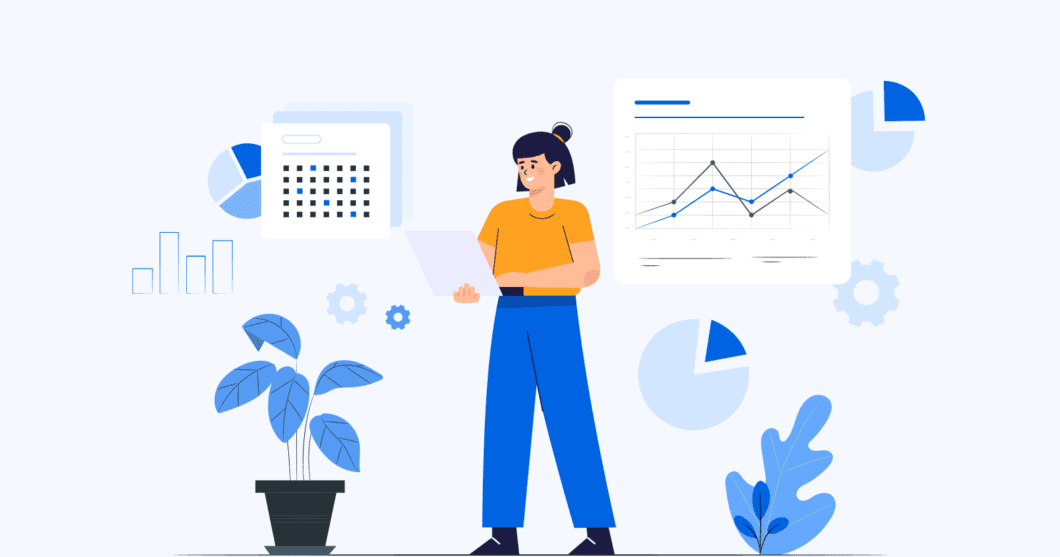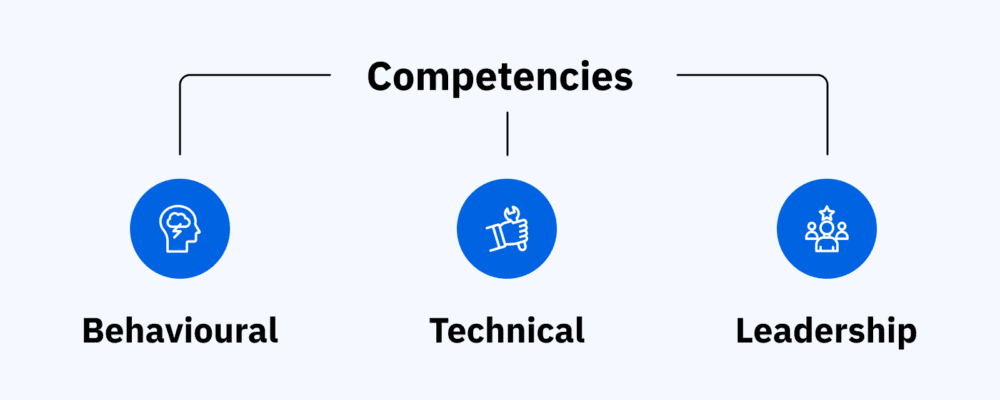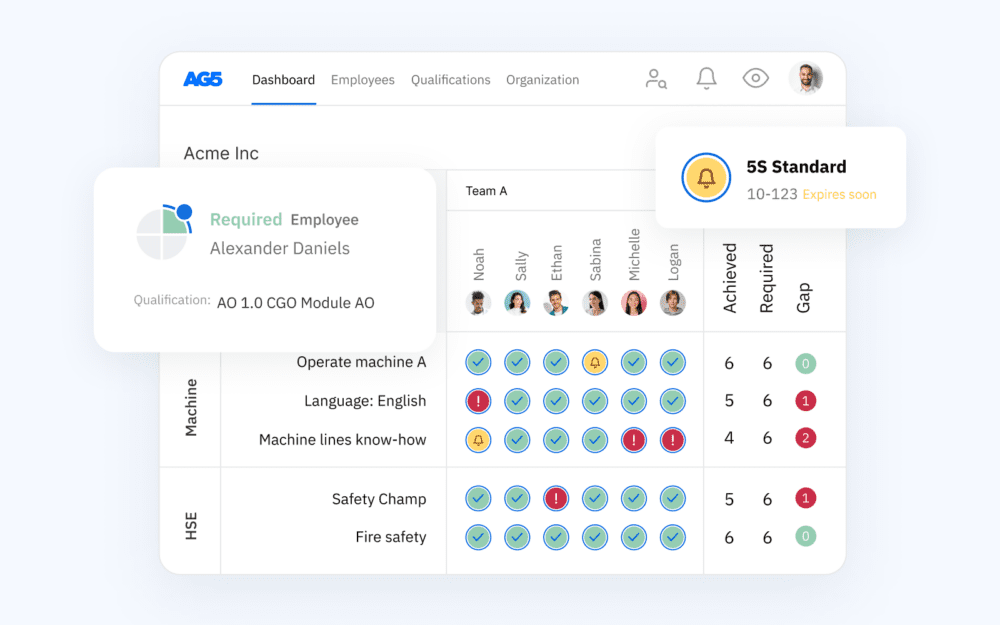A full breakdown of competency development
In this article, we’ll take a close look at competency development, its main benefits, and how you can develop a competency development framework for your organization.

Competency development is a goal-oriented method of helping your employees sharpen their existing competencies or develop new ones. In this article, we’ll take a close look at competency development, its main benefits, and how you can develop a competency development framework for your organization.
What are competencies?Copied
Competencies are often conflated with skills, but they are distinct concepts. [1]
The main difference between a competency and a skill is that competencies are much broader.
Competencies are the sum of an individual’s:
- Knowledge of a certain topic or within a certain field
- Skills (the physical and mental actions or tasks that someone has mastered)
- Aptitudes and character traits
What is competency development?Copied
Competency development is the practice of developing one or several competencies in a specific way and in a particular direction.
Here, “development” refers to:
- Improving existing competencies through targeted training, gaining additional knowledge, changing attitudes
- Adding new competencies to employees’ professional arsenal through continuous learning and new challenges
From an organizational perspective, competence development serves two main purposes:
- To improve alignment between employees’ competencies and the strategic goals of the organization
- To stimulate and improve employee involvement in the organization, resulting in higher rates of employee engagement less attrition.
The benefits of competency developmentCopied
Good competence development offers many benefits, both for organizations and individual employees. Let’s take a look at a few of the major benefits of competence development.
Improved competitiveness
Competence development improves the match between the strategic goals of an organization and the competencies of its employees. This strengthens your competitive position and helps future-proof your organization.
Improved decision-making
Competence development facilitates careful mapping of all the strengths and weaknesses of your workforce. This information allows you to increase the efficiency of your business processes and avoid over- or under-staffing of teams or specialized projects.
Improved recruitment and retention
No organization wants to be a revolving door. In view of business continuity, it is important to attract the right people and commit them to the organization for longer periods of time. Competency development makes this easier. You gain an understanding of what competencies you need, while offering employees opportunities for development – itself an enormous factor in employee retention.
Improved workplace safety
Once all employees have a clear understanding of competencies and skills, production lines and production processes can be organized more safely from start to finish. This results in a workplace that is safer and more compliant with industry regulations and standards.
Employee growth
Effective competence development facilitates your employees’ professional development, as it allows them to better understand their aptitudes an potential. Using this knowledge, they can sharpen their existing competencies – and develop new ones – in a more targeted way.
Types of competenciesCopied
Competencies typically fall within three general categories. [2]
- Behavioural – encompassing soft skills such as communication and adaptability that are key for successful collaboration and positive interpersonal dynamics
- Technical – focusing predominantly on expertise for specific, sometimes specialized roles
- Leadership – an employee’s ability to strategically think, navigate change, and make impactful and ethical decisions
To categorize competencies, you will first need to identify them individually. We’ll take a look at this in the following section.

Identifying competenciesCopied
Because competencies are not the same as skills, organizations often require their employees to meet the same levels of competency in certain areas.
The level of competency that you require employees to possess in a certain area is called a threshold competency.
Typically, organizations define a threshold competency for a given area – communication, for instance. This means that all employees hired by that organization must possess a predefined level of competency for communication.
Of course, specialized roles may require higher levels of communication – or any other type of – competency. These levels are usually defined in the early stages of any given recruitment initiative.
Identifying – and later defining – competencies requires a holistic look at all the skills, knowledge, and aptitudes that are required for specific roles. [3] To put this into practice, most organizations use a competency framework.
What competency development looks like in practiceCopied
Your approach to competency development will depend on your organization and the competencies it requires from employees. However, you can lay a foundation for competency development with a competency framework. Here, we’ll offer a four-step solution to creating one.
Step 1: Preparation
Putting competence development into practice begins with sound preparation.
- First, determine what goal you want to achieve with competence development
- What information do you want to collect?
- How – and for what purpose – do you want to use this information?
Step 2: Collecting information
The more data you have, the more precisely you will be able to identify and define the competencies you and your teams need. Here are a few tips for successful information gathering.
- Observe how your employees do their jobs. This method is especially useful when it comes to tasks that require manual labor (factory work, construction, etc.)
- Conduct staff interviews, either individually or in groups
- Design a survey or questionnaire and distribute it to all relevant employees
- Analyze work and business processes. Verify whether they are aligned with the strategic goals of your organization, as well as their efficiency
Step 3: Building the framework
You have now collected all the relevant information. This means you can now start building a framework for competency development.The following steps will make the building process easier and more transparent.
- Group all the collected information into competence categories
- Divide competencies and their associated employees into subcategories – and continue to further refine them
- Identify and name the competencies at the individual level
Step 4: Implementing the framework
With the final framework ready to go, it’s time to implement it within your organization. Be sure to communicate this to all involved employees, as universal support is an important precondition for successful competency development.
Below you will find a few tips on framework adoption.
- Ensure a clear connection between individual competencies and business objectives
- Reward competencies with a fitting salary and proper growth opportunities
- Provide high-quality coaching and training for competency development
- Keep it simple – a framework for competence development has to be clear and understandable to everyone who uses it
Visualize your team’s competency development with AG5Copied
Competency development is more concrete and easier when competencies are visualized. The best way to do this is with a skills matrix. A skills matrix offers several benefits, among them:
- You can quickly and easily see the competencies your employees possess – and and those your organization still missing
- You can tailor and customize a skills matrix to specific teams, departments, locations, or managers.
- It’s easier and less time-consuming for you to find replacements for staff out sick, or successors for employees leaving the organization
Additionally, you can use skills management software to view and automatically adjust skills matrices in real time. This saves you the headache of using spreadsheet-based skills matrices that are error-prone and complicated.
Want to see it in action? Schedule a free, live, 15-minute demo of AG5’s for a custom look at how our skills management software will help you develop competencies across your organization.

Sources Copied
- Change view: Table
-
APA
| # | Source title | Description | Publication | Retrieved | Source URL |
|---|---|---|---|---|---|
| 1 | Types Of Competencies (And How They Differ From Skills) | Indeed | - | April 16, 2024 | https://in.indeed.com/career-a.. |
| 2 | Job Competencies: Definition, Types and Examples (2024). | WikiJob | - | April 16, 2024 | https://www.wikijob.co.uk/inte.. |
| 3 | Identification of Competencies | Unesco | - | April 16, 2024 | https://unevoc.unesco.org/home.. |
Author Copied
Revisions Copied
Sources updated, headers checked.
Written by: Rick van Echtelt
Technically reviewed by: Adam

